Squaw Valley Ski Resort
Squaw Valley Ski Resort, then known as Squaw Valley, was the host site for the 1960 Winter Olympics.[1] Located in Olympic Valley, California, Squaw Valley Ski Resort covers 3,600 acres (15 km2) employing 30 chairlifts and the only funitel in the United States. It is the second-largest skiing complex in the Lake Tahoe area after Heavenly Mountain Resort[2]
| Squaw Valley Alpine Meadows | |
|---|---|
 The Village at Squaw Valley, July 2007 | |
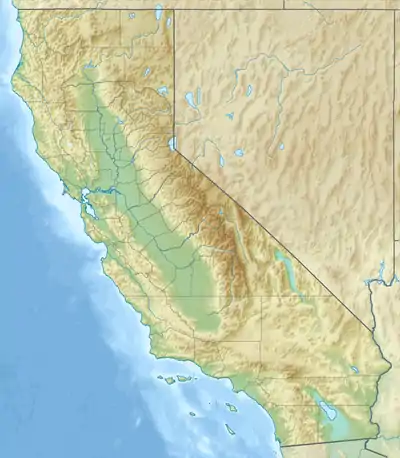 Squaw Valley Alpine Meadows Location in California  Squaw Valley Alpine Meadows Squaw Valley Alpine Meadows (the United States) | |
| Location | Squaw Peak Placer County, California |
| Nearest major city | Truckee, California Reno, Nevada |
| Coordinates | 39.196°N 120.235°W |
| Vertical | 2,850 ft (870 m) |
| Top elevation | 9,050 ft (2,760 m) |
| Base elevation | 6,200 ft (1,890 m) |
| Skiable area | 4,000 acres (16.2 km2) |
| Runs | 177+ |
| Longest run | 3.2 miles (5.1 km) Mountain Run |
| Lift system | 30 |
| Lift capacity | 58,000 per hour |
| Terrain parks | 3 |
| Snowfall | 450 in (1,140 cm) |
| Snowmaking | Yes |
| Night skiing | No |
| Website | squawalpine |
In 2012, Squaw Valley and Alpine Meadows were combined to offer joint access to 6,200 acres (25 km2), 43 lifts and over 270 trails.[3] The resort attracts approximately 600,000 skiers a year.[4]
Located northwest of Tahoe City in the Sierra Nevada with a base of 6,200 ft (1,890 m) and a skiable 3,600 acres (15 km2) across six peaks, the resort tops out at 9,010 ft (2,750 m) at Granite Chief.[5][6] The resort averages 450 inches of snowfall every winter.[7] The Squaw Valley Aerial Tramway rises 2,000 ft (610 m) to an elevation of 8,200 ft (2,500 m) above sea level. The resort is also home to several annual summer events.
In August of 2020, the owners announced their commitment to remove the word “squaw” from the resort's name by summer 2021 as the use of the term is an ethnic and sexual slur.[8][9][10]
History
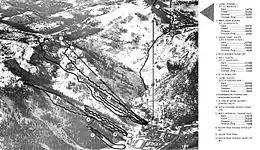
1960 Winter Olympics
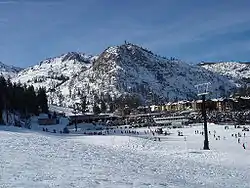
Former University of Nevada star skier, Wayne Poulsen, purchased the first 2,000 acres (8.1 km2) of Squaw Valley Ski Resort from the Southern Pacific Railroad.[11] Poulsen already had a history in the area: in 1931, he had placed third at an Olympic trials at Granlibakken in Tahoe City.[12] Shortly after, Poulsen met Harvard alumnus and trained lawyer Alex Cushing, who brought capital, political connections, and increased access to the project.[11] Cushing had fallen in love with Lake Tahoe after a visit to the Sierra Nevada in 1946.[12] After a disagreement over the resort's future, Cushing gained control of the project and became the chairman of Squaw Valley Ski Corporation. The resort opened in 1949, and Cushing remained its chairman until his death.[11]
Cushing modeled the resort after European ski destinations by locating a swimming pool, ice rink, roller disco, and restaurants on the mountain instead of at the base. His designs also brought advanced lift technology to the U.S. for the first time.[11] When Squaw Valley opened, its Squaw One lift was deemed the longest double chairlift in the world.[12]
Squaw Valley's success can be largely attributed to the visibility that came from hosting the 1960 Winter Olympics, a direct result of Cushing's effort and determination. During the planning stages of the 1960 Olympics, Innsbruck, Austria, was the leading choice for the Olympic site. In 1955, however, Cushing secured the bid after winning over the International Olympic Committee in Paris with a scale model of his planned Olympic site. The Winter Olympics in 1960 were the first to be televised live, making the games accessible to millions of viewers in real-time. The event signaled the rise of U.S. skiing to the level of world-famous European skiing, and Squaw Valley's preparedness for the games showed the international community that U.S. ski resorts offered world-class facilities.[11]
Squaw Valley hosted World Cup races in 1969 with four technical events: slalom and giant slalom for both men and women. American Billy Kidd won the men's slalom, followed by U.S. teammates Rick Chaffee (4th) and Spider Sabich (10th)[13] of Kyburz. The 1969 season saw a record snowpack at Squaw Valley;[14] and over eight feet (2.4 m) of new snow cancelled the downhills.[15][16] After an absence of 48 years, women's technical races returned in 2017 and overall leader Mikaela Shiffrin of Colorado won both events.
In 1971, following several years of financial losses, the state announced they would seek bids to buy Squaw Valley. After a failed bid by John Fell Stevenson, Dick Baker and his Australian company Mainline Corporation successfully bid $25 million plus 1,500 acres from the Poulsens. In August 1974 the Australian company Mainline Corporation collapsed and Squaw Valley was again back on the market for sale.[17]
In 1978, Squaw Valley experienced one of the worst cable car accidents in history. On a stormy afternoon late in the season on Saturday, 15 April,[18][19] the Tram came off of one of its cables, dropped 75 feet (23 m) and then bounced back up, colliding with a cable which sheared through the car; four were killed and 31 injured.[20][21]
Squaw Valley was purchased by private equity group KSL Capital Partners in November 2010.[22] In September 2011, Alpine Meadows Ski Resort and Squaw Valley Ski Resort announced their intention to merge ownership. The merger united the two popular ski destinations under common management by Squaw's Valley's parent company, KSL Capital Partners, LLC. A year later, Squaw Valley and Alpine Meadows Ski Resort merged under the new umbrella leadership of Squaw Valley Ski Holdings, LLC. The new company operates as one, with joint lift tickets and single season passes for visitors and free shuttles between its locations, but preserves the individuality of the two resorts.[23] In 2017, KSL Capital, in partnership with Aspen/Snowmass (Henry Crown and Company), formed Alterra Mountain Company, which then became the primary owner of Squaw Valley.
In 1960, during the VIIIth Winter Olympic Games, Squaw Valley was designated as California Historical Landmark Number 724. A marker was placed identifying Squaw Valley as a Pioneer Ski Area of America. The marker's plaque commemorated 100 years of organized skiing in "mining towns in the Sierra Nevada, particularly Whiskey Diggs, Poker Flat, Port Wine, Onion Valley, La Porte, and Johnsville".[24]
Chairlifts
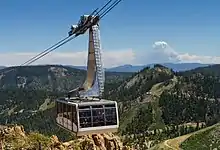
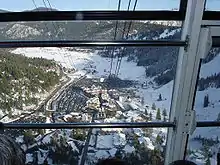

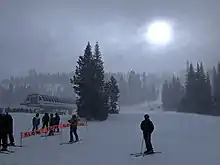
Lower mountain chairs (elev. 6200')
| Name | Type | Vertical rise | Capacity per hour | General terrain |
|---|---|---|---|---|
| Aerial Tram | Tram | 1,886 ft (575 m) | 700 | Access to upper mountain |
| Gold Coast Funitel | Funitel | 1,742 ft (531 m) | 4,000 | Access to upper mountain |
| First Venture | Fixed-grip triple | 98 ft (30 m) | 800 | |
| SnoVentures Carpet | Carpet | 35 ft (11 m) | 2,400 | |
| Tucker | Carpet | 15 ft (4.6 m) | 2,000 | |
| Exhibition | Fixed-grip quad | 808 ft (246 m) | 1,636 | |
| Far East Express | Detachable six-pack | 960 ft (290 m) | 2,600 | |
| Red Dog | Fixed-grip triple | 1,238 ft (377 m) | 1,800 | |
| Squaw Creek | Fixed-grip triple | 1,309 ft (399 m) | 700 | |
| Squaw One Express | Detachable quad | 1,660 ft (510 m) | 2,400 | Access to upper mountain |
| KT-22 Express | Detachable quad | 1,767 ft (539 m) | 2,100 | |
| Olympic Lady | Fixed-grip double | 1,175 ft (358 m) | 1,100 | |
| Boon | Carpet | |||
| Murphy and Wiley | Carpet |
Upper mountain chairs (elev. 8200')
| Name | Type | Vertical rise | Capacity per hour | General terrain |
|---|---|---|---|---|
| Bailey's Beach | Fixed-grip triple | 95 ft (29 m) | 1,266 | |
| Belmont | Fixed-grip double | 75 ft (23 m) | 914 | |
| The Pulley | Rope tow | |||
| Mountain Meadow | Fixed-grip triple | 222 ft (68 m) | 1,805 | |
| Emigrant | Fixed-grip triple | 761 ft (232 m) | 1,558 | |
| Gold Coast Express | Detachable six-pack | 563 ft (172 m) | 3,075 | |
| Big Blue Express | Detachable six-pack | 557 ft (170 m) | 3,000 | |
| Shirley Lake Express | Detachable six-pack | 717 ft (219 m) | 3,200 | |
| Siberia Express | Detachable six-pack | 916 ft (279 m) | 3,000 | |
| Solitude | Fixed-grip triple | 660 ft (200 m) | 1,800 | |
| Broken Arrow | Fixed-grip double | 302 ft (92 m) | 1,200 | |
| Granite Chief | Fixed-grip triple | 999 ft (304 m) | 1,565 | |
| Headwall Express | Detachable six-pack | 1,750 ft (530 m) | 2,400 | |
| Silverado | Fixed-grip triple | 1,371 ft (418 m) | 1,346 |
Terrain aspect[25]
- North: 50%
- East: 40%
- West: 2%
- South: 8%
Alpine Meadows gondola connection
Squaw Valley Ski Holdings, LLC seeks to connect the Alpine Meadows (ski resort) with a "Base-to-Base" gondola.[27][28][29] Resort owners need permission from local land managers, including Placer County and the Tahoe National Forest who are currently studying the proposed project's environmental impacts.[30] A number of conservation organizations, including Sierra Watch and the Sierra Club, consider the proposed gondola a threat to Granite Chief Wilderness.[31][32] In July 2019 Sierra Watch and Granite Chief Wilderness Protection League filed a lawsuit with Squaw Valley challenging Placer County's approval of the gondola project. In January 2020 the United States Forest Service issued its Record of Decision approving a route crossing federal lands.[33] In February 2020, the litigants dropped the suit in exchange for Squaw Valley's commitment to implement measures to mitigate the impact towards the Sierra Sierra Nevada yellow-legged frog (an endangered species).[34] The approved gondola is planned to cross the private ski area, White Wolf Mountain, which is owned by Troy Caldwell. Caldwell supports the gondola.[35]
Development controversy
Separate from the approved Squaw Alpine proposed gondola, Squaw Alpine has also proposed a large development in the existing Squaw Valley parking lot area. In 2016, Squaw Valley Ski Holdings submitted a final application for entitlements for its proposed Village at Squaw Valley Specific Plan, a $1billion plan that prompted the Attorney General of California to write a letter of concern to Placer County.[36] The plan would include 850 hotel and condominium units[37] and a 96-foot-tall "Mountain Adventure Camp"[38] featuring a year-round indoor waterpark.[39] According to the environmental review for the project, new development is projected to add 3,300 new car trips to local roads on peak days, and the project would have twenty "significant but unavoidable" impacts".[40]
Sierra Watch created a grassroots campaign to “Keep Squaw True”, holding public events and circulating an online petition in opposition to KSL Capital Partners' proposed expansion plan.[41][42]
In November 2016, the Placer County Board of Supervisors approved KSL's controversial development proposal[43][44] in spite of opposition from local conservation organizations, including Sierra Watch.[45] Sierra Watch filed suit to overturn those approvals for violating the California Environmental Quality Act in December 2016.[46]
In 2017, resort owners added a roller coaster to their development proposal.[47]
Squaw Valley name controversy
The use of the word "squaw" is considered to be a derogatory and offensive ethnic and sexist slur.[8]
In mid-2020, the owners of Squaw Valley Alpine Meadows acknowledged the controversial nature of the term. Company spokesperson Christine Horvath stated that the business was creating a plan to review the use of the term “squaw” and invite regional tribal leaders to provide guidance.[48][49][50]
On August 25, 2020, in response to long-running complaints from the Washoe Tribe of Nevada, Ron Cohen, President and COO of Squaw Valley Alpine Meadows, issued a statement which included the following apology:
While we love our local history and the memories we all associate with this place as it has been named for so long, we are confronted with the overwhelming evidence that the term ‘squaw’ is considered offensive.
He intended that action will be taken to change the resort's name which will be announced in summer 2021.[9][10]
References
- "Squaw Valley 1960 Winter Olympics". Olympics. Retrieved 21 October 2012.
- "Lift World: Lift-Database – Funitels". Seilbahntechnik. Archived from the original on 10 February 2012. Retrieved 21 October 2012.
- Smith, Kelsey (27 September 2011). "Set the rumors to rest – Squaw & Alpine merge". Transworld Business. Retrieved 21 October 2012.
- "About Squaw Valley". The Wanderlust Festival. Archived from the original on 17 December 2014. Retrieved 21 October 2012.
- "Granite Chief, CA". TopoQuest. Retrieved 21 October 2012.
- "The Mountain". Squaw Valley Ski Resort. Retrieved 21 October 2012.
- "Squaw Valley Snowfall Tracker". Squaw Valley Alpine Meadows. Retrieved 28 August 2020.
- King, Richard C. (2003). "De/Scribing Squ* w: Indigenous women and imperial idioms in the United States". American Indian Culture and Research Journal. 27 (2): 1–16. doi:10.17953/aicr.27.2.97761545p7401436. Retrieved 26 August 2020.
- "Squaw Valley Name Change". Squaw Valley Alpine Meadows. 25 August 2020. Retrieved 25 August 2020.
- "Squaw Valley to drop 'racist, sexist' term from name". SFChronicle.com. 25 August 2020. Retrieved 25 August 2020.
- "History of Squaw Valley". Skibutlers. Retrieved 21 October 2012.
- "Lake Tahoe History". Ski Lake Tahoe. Archived from the original on 28 January 2013. Retrieved 21 October 2012.
- "Kidd dazzles skiing field; Kiki falls in slalom race". The Bulletin. (Bend, Oregon). UPI. 1 March 1969. p. 8.
- "World Cup set despite snow". Eugene Register-Guard. (Oregon). Associated Press. 28 February 1969. p. 5B.
- "Snow worry for officials of World Cup". Spokesman-Review. (Spokane, Washington). Associated Press. 28 February 1969. p. 16.
- "Schranz, Gabl take on World Cup challengers". The Bulletin. (Bend, Oregon). UPI. 28 February 1969. p. 8.
- Ancinas, Eddy Starr (7 October 2019). Squaw Valley and Alpine Meadows: Tales from Two Valleys 70th Anniversary Edition. Arcadia Publishing. ISBN 978-1-4671-4405-6.
- "Three killed as cable car falls 30 feet". Eugene Register-Guard. (Oregon). Associated Press. 16 April 1978. p. 2A.
- "4 killed, 30 hurt on tram". Deseret News. (Salt Lake City, Utah). Associated Press. 17 April 1978. p. A1.
- "Cable car accident killing 4 to be analyzed by engineers". Eugene Register-Guard. (Oregon). Associated Press. 17 April 1978. p. 5A.
- http://www.moonshineink.com/sections/spot/30-years-later
- Marino, Jonathan (24 November 2010). "Squaw Valley Bought by KSL Capital Partners". Mergers & Acquisitions. Retrieved 21 October 2012.
- Reynolds, Christopher (28 September 2011). "At Lake Tahoe's North Shore, Squaw Valley and Alpine Meadows come together". Los Angeles Times. Retrieved 21 October 2012.
-
- "Pioneer Ski Area of America, Squaw Valley (No. 724 California Historical Landmark)". Sierra Nevada Geotourism. Retrieved 6 September 2020.
- Steiner, Christopher. "ZRankings Topological Survey – Squaw Valley". ZRankings Best Ski Resorts – Squaw Valley. ZRankings.
- "Historical Snowfall". On The Snow.
- Gondola | Squaw Alpine
- Moffit, Bob (15 April 2015). "Squaw Valley – Alpine Meadows Gondola Project Progresses", Capitol Public Radio News.
- Environmental Impact Statement, Squaw Valley Alpine Meadows Base to Base Gondola Project.
- Environmental Impact Statement, Squaw Valley Alpine Meadows Base to Base Gondola Project
- Martin, Hugo (16 April 2015). "Conservation group opposes Tahoe-area ski resort gondola plan", Los Angeles Times.
- Moffit, Bob (16 April 2015). "Conservation Group Opposes Gondola Project On Private Land", Capitol Public Radio News.
- USDA Record of Decision 2020
- Kelly, Jemima (21 February 2020). "Bitcoin cash is expanding into the void". Sierra Sun. Retrieved 6 July 2020.
- Whiting, Sam (9 March 2008). "Troy Caldwell's dream of an Alpine-to-Squaw route lives on at his White Wolf Mountain". The San Francisco Chronicle. Retrieved 21 October 2012.
- Associated Press (16 April 2015). "“$1-billion Squaw Valley development plan moves closer to approval", Los Angeles Times.
- Placer County (April 2016). "Village at Squaw Valley Specific Plan, pg.3–6", submitted by Squaw Valley Real Estate, LLC.
- Id. at pg. B-22, Development Standards and Guidelines, Placer County
- Id at pg. 3–13, The Village at Squaw Valley Specific Plan, Placer County
- Placer County Village at Squaw Valley Specific Plan Final Environmental Impact Report (FEIR) 3.2.4–326, Prepared by Ascent Environmental for Placer County, April 19, 2016.
- Action – Sierra Watch
- Brannan, Brad (19 April 2016). "Squaw Valley chief faces community opposition to expansion", The Sacramento Bee.
- Press Release (15 November 2016). "Placer County Supervisors approve Village at Squaw Valley Project", Placer County E-News.
- Fimrite, Peter (16 November 2016). "Huge Squaw Valley expansion approved, but meets with objections", The San Francisco Chronicle.
- Brannan, Brad (6 June 2016). "Proposed high-rises generate Squaw Valley controversy", The Sacramento Bee.
- Brannan, Brad (15 December 2016). "Environmentalists challenge Squaw Valley expansion", The Sacramento Bee.
- Fimrite, Peter (16 September 2017). "Timberline Twister roller coaster tying Squaw Valley in knots", The San Francisco Chronicle.
- Hoplamazian, Mara (19 June 2020). "Squaw Valley to discuss removing slur against Native Americans from California resort's name". Sacramento Bee. Retrieved 4 July 2020.
- Associated, Press (25 August 2020). "California: popular ski resort to remove racist term from its name". The Guardian. Retrieved 26 August 2020.
- Scacco, Justin (3 July 2020). "'It's just time': Washoe Tribe rep weighs in on use of 'squaw'". Tahoe Daily Tribune. Retrieved 26 August 2020.
External links
![]() Media related to Squaw Valley at Wikimedia Commons
Media related to Squaw Valley at Wikimedia Commons
- Official website
- SnowGuide.org—Squaw Valley
- 3dSkiMaps.com—Squaw Valley Ski Resort
- Squaw Valley Snow Forecast—Squaw Valley Snow Forecast
- Ski resorts Squaw Valley at Skiresorts-Test.com
